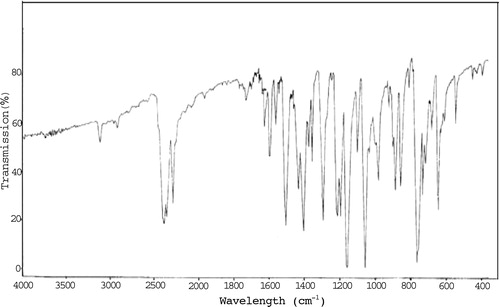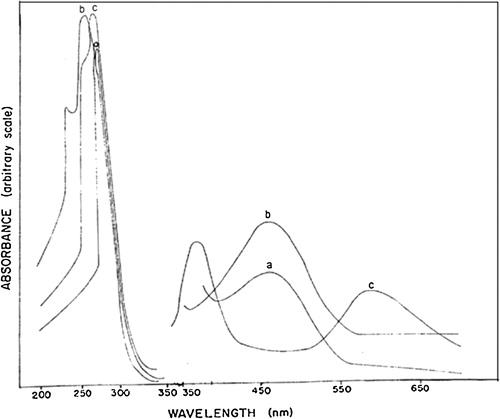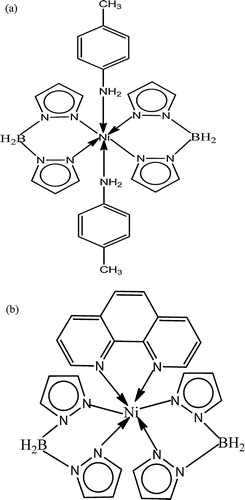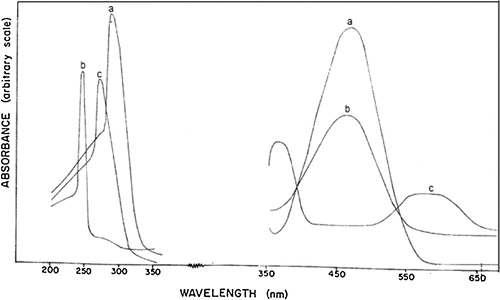 ?Mathematical formulae have been encoded as MathML and are displayed in this HTML version using MathJax in order to improve their display. Uncheck the box to turn MathJax off. This feature requires Javascript. Click on a formula to zoom.
?Mathematical formulae have been encoded as MathML and are displayed in this HTML version using MathJax in order to improve their display. Uncheck the box to turn MathJax off. This feature requires Javascript. Click on a formula to zoom.Abstract
Co(II), Ni(II) and Cu(II) complexes of dihydrobis(1-pyrazolyl)borate and their adducts with some Lewis bases have been prepared and characterized by elemental analyses, IR and UV–vis spectroscopic techniques. The adducts were either 1:1 or 1:2 complexes depending on whether the Lewis base was bidentate or monodentate. The results indicate that adducts with 1,10-phenanthroline were the most stable due to the chelating effect of the Lewis base. The order of reactivity of the complexes was determined to be Ni(H2BPz2)2 > Cu(H2BPz2)2 > CoH2(BPz2)2 > Co(H2BPz2)2. The effects of various solvents (i.e., benzene, chloroform and DMF) on the structure were studied. The solvents appear to minimally affect the visible spectra of Co(H2BPz2)2. The Ni(H2BPz2)2 and Cu(H2BPz2)2 adducts exhibit a four-coordinate structure in non-coordinating solvents. However, in coordinating solvents, such as DMF, the adducts exhibit six-coordinate structures.
1 Introduction
Poly(1-pyrazolyl)borates are a class of uninegative ligands with excellent ligating properties. These ligands are sometimes referred to as “Scorpionate” ligands with “pinch and sting” capabilities [Citation1]. Poly(1-pyrazolyl)borates function as bidentate ([H2B(Pz)2]− (I)), tridentate ([HB(Pz)3]− (II)) and tetradentate ([B(Pz)4] (III)) chelating ligands [Citation2]. Depending on the number of pyrazole groups attached to the boron atom, these scorpionates (I, II and III) are typically referred to as dihydrobispyrazolylborates, hydrotrispyrazolylborates and tetrakispyrazolylborates, respectively [Citation2,Citation3]. Poly(1-pyrazolyl)borates form a variety of stable coordination compounds with transition metal ions and organometallic compounds [Citation1–Citation6].
The syntheses and characterization of transition metal complexes of poly(1-pyrazolyl)borate have continued to be of much interest since its discovery nearly four decades ago. For example, shortly after its discovery, the syntheses and characterization of several metal complexes of the [H2B(Pz)2]2M, [HB(Pz)3]M and [B(Pz)4]2M (where M = Mn, Fe, Co, Ni, Cu, Zn, Cd, Pb and Hg) type were reported [Citation2]. In addition, several studies of the coordination chemistry of various hydrotrispyrazolylborates have been reported [Citation7–Citation14]. The reaction of poly(1-pyrazolyl)borate metal complexes with other ligating compounds has also attracted much attention. With lanthanides and actinides, poly(1-pyrazolyl)borates form air and moisture stable complexes [Citation15–Citation18]. The solid-state structures of this group of compounds exhibit interesting structural geometries. For example, uranylhydrotris(3,5-dimethlypyrazoly)boratotrichlorotetrahydrofuran (μ[HB(3,5-Me2Pz)3]Cl3(THF)) exhibits a capped octahedral geometry with a seven coordinate uranium centre [Citation10]. When the three chloro and THF ligands were replaced with cyclopentadienide and alkoxide/aryloxide, respectively, the resulting product adopted an asymmetric metal centre [Citation3,Citation7–Citation10].
Many transition metal complexes are known to form adducts with Lewis bases [Citation19–Citation21] due to the ability of transition metal ions in these complexes expanding their coordination shells. For example, a tetrahedral or square planar complex can expand its coordination shells to form a five-coordinate 1:1 adduct or a six-coordinate 1:2 adduct depending on the type and number of Lewis base molecules involved in the adduct formation. For example, the coordination number of a low-spin square planar nickel(II) complex can be increased by the addition of two molecules of a monodentate Lewis base to form a high-spin octahedral adduct [Citation19]. Transition metal complexes of poly(1-pyrazolyl)borates and Lewis base ligands have been extensively studied. However, studies of metal compounds containing a mixture of these two ligands are rare in the literature. Gunnoe and co-workers have pioneered adduct formation chemistry of transition metal-poly(1-pyrazolyl)borates with π-bonding ligands, such as phosphines, phosphates and carbon monoxide [Citation22,Citation23]. Here, we have expanded this pioneering effort by incorporating Lewis base ligands into the coordination sphere of transition metal-poly(pyrazolyl)borate complexes. The resulting adducts were characterized using physical, infrared and electronic spectroscopic techniques.
2 Experimental
Potassium borohydride, pyrazole, transition metal salts and the Lewis bases were obtained from commercial sources and used without further purification. Reagent grade solvents were used without further purification. The melting points were determined in open capillaries using an electrothermal melting point apparatus and are uncorrected. The UV-visible absorption spectra of the adducts were recorded on a Pye Uranium SP 80-150 UV-visible spectrophotometer in the Department of Chemistry, University of Ilorin, Nigeria. The infrared spectra were recorded using KBr pellets from 4000 to 400 cm−1. The mass spectra were measured by introducing the sample at room temperature into the ion source of the mass spectrometer (70 eV). The ion source temperature was varied to obtain good quality spectra. The infrared mass spectral analysis and microanalysis (C, H, N) were performed at the Institute fur Anorganische Und Analytische Chemie, Technische Universitat, Berlin, Germany.
2.1 Preparation of Ni(II), Co(II) and Cu(II) dihydrobis(1-pyrazolyl)borate complexes
The complexes were prepared using the same general method described here for nickel(II)bis(1-pyrazolyl)borate. Nickel(II) chloride (0.71 g, 0.0055 mole) and potassium dihydrobis(1-pyrazolyl)borate (KH2B(Pz)2), (2 g, 0.011 mole), which was obtained according to a previously published procedure [Citation2], were separately dissolved in 15 cm3 of distilled water. The two clear solutions were mixed together at room temperature and stirred for several minutes until a copious amount of precipitate was formed. Then, the resulting precipitate was washed with distilled water, dried in air and recrystallized from hot toluene.
The general equation for the reaction is shown in , and the physical and electronic data are listed in .
Table 1 Physical and electronic absorption spectral data in benzene for the M(H2BPz2)2 (M = Co, Ni and Cu) complexes.
2.2 Preparation of the adducts
The nickel(II), cobalt(II) and copper(II) bis(1-pyrazolyl)borate adducts were prepared by reacting the transition metal complexes with a general formula of M[H2B(Pz)2]2 with Lewis bases. The bidentate and monodentate Lewis bases were reacted with M[H2B(Pz)2]2 at room temperature in a 1:1 and 1:2 ratio, respectively. Each reactant was dissolved in a minimum quantity of benzene, and the two solutions were mixed together and stirred. The resulting solution was allowed to stand at room temperature with occasional stirring for approximately thirty to sixty minutes. The resulting solids were filtered under suction and recrystallized from an appropriate solvent. The adduct solutions that did result in immediate precipitates were allowed to evaporate slowly at room temperature while unstable solutions were stored in a refrigerator. The resulting precipitates were filtered under suction. The physical and analytical data for the adducts are reported in .
Table 2 Physical and analytical data for the adducts.
3 Results and discussion
KH2B(Pz)2 is a white water soluble salt, and when dry, it is stable in air and moisture. KH2B(Pz)2 can be stored in the solid state for several years. The infrared spectrum of KH2B(Pz)2 contains a characteristic νBH2 multiplet between 2460 and 2230 cm−1. The dihydrobis(1-pyrazolyl)borate transition metal complexes with a general formula of M(H2BPz2)2 (M = Ni, Co and Cu) that were prepared in this study were isolated as stable solids. These solids are typically coloured, melt at moderate temperatures and exhibit properties that are consistent with those previously reported for these compounds [Citation2]. The complexes are moderately soluble in common organic solvents.
Lewis base adducts (i.e., general formula of M(H2BPz)2D, (M = Ni, Co, or Cu, D = monodentate or bidentate Lewis base)) were prepared in benzene solutions. These adducts are typically insoluble in benzene and fairly stable in air. The aniline, pyridine, piperidine and hexamethylphosphoramide derivatives are relatively unstable at room temperature and were stored in a refrigerator at 0 °C. The order of reactivity of the complexes M(H2BPz2) with the Lewis bases was determined to be Ni(H2BPz2)2 > Cu(H2BPz2)2 > Co(H2BPz2)2. In addition, the reaction of the complexes with bidentate Lewis bases was faster and yielded more stable adducts than the reactions with monodentate Lewis bases. The analytical data () indicate that the adducts are either 1:1 or 1:2 complexes depending on whether the Lewis base is bidentate or monodentate, respectively, as represented by the following equations:
For bidentate Lewis base:
For monodentate Lewis base:
3.1 Infrared spectra studies
The infrared spectra of the Lewis base adducts have similar general features. These spectra are rather complex due to the presence of numerous vibrational modes (e.g., see for the infrared spectrum of Ni(BPz2)2DMP). However, in general, these spectra are characterized by sharp bands. The diagnostic frequencies of the observed bands are collected in . All of the spectra exhibit the characteristic νBH2 stretching multiplet between 2450 and 2280 cm−1, indicating the presence of the M(H2BPz2)2 basic moiety in the Lewis base adducts [Citation2]. The differences between the spectra are primarily due to the vibrational modes of the coordinated Lewis base, which varies from one adduct to another. Frequency assignments have been made by comparing the measured absorption bands to those found for similar complexes in the literature [Citation24–Citation27]. With the exception of the toluidine adduct of Ni(H2BPz2)2, the infrared spectra of all of the amine adducts exhibit the asymmetric ν(N–H) vibrational modes in a spectral range of 3350 to 3320 cm−1. The symmetric ν(N–H) modes appeared as very sharp bands of medium intensity in the range 3290–3270 cm−1. The observed N–H stretching frequencies of the M(H2BPz2)2Dn (n = 1 or 2) adducts are less intense compared to those of the free Lewis bases, indicating that the NH groups in the adducts are coordinated [Citation24]. The Ni(H2BPz2)2D2 adducts exhibit a very broad, intense band in the 3600–3300 cm−1 region instead of the two expected bands in this region. It is important to note that the quality of the spectrum is poor. The band located at approximately 1590 cm−1 corresponded to the ν(N–H) deformation mode, which further confirmed that the bond between the metal and ligand occurred through the nitrogen of the primary amines [Citation25]. The 1,10-phenanthroline and 2,9-dimethyl-1,10-phenanthroline adducts typically exhibit ν(C–H) vibrational modes between 1600 and 1580 cm−1, which is consistent with coordinated C=N [Citation25].
Table 3 Important observed infrared bands (cm−1) for the adducts.
Free oxine exhibits a broad ν(O–H) band due to hydrogen bonding at 3500–3200 cm−1 [Citation26]. The Ni(H2BPz2)2Ox spectrum has a very broad band with strong intensity in the 3500–2800 cm−1 range due to the presence of a water molecule in the adduct and the coordination of the OH group of the oxine to the metal ion. In the spectrum of Co(H2BPz2)2Ox, a similar absorption band was observed between 3540 and 3380 cm−1. However, in the Cu(H2BPz2)2Ox spectrum, this band was not observed, which most likely indicates the non-coordination of the oxine moiety to the Cu centre. This result is supported by the mass spectral data because no mass spectral line corresponding to the oxine moiety was observed in the mass spectral data of the corresponding Cu adduct. In the spectra of both Ni(H2BPz2)2Ox and Co(H2BPz2)2Ox, a strong ν(C=N) band was observed at 1575 cm−1, which corresponds to the binding of the nitrogen of oxine to the metal ion centre. This band was conspicuously absent in the Cu(H2BPz2)2Ox spectrum, which provided additional evidence for the absence of oxine in the adduct ().
The bands due to the metal-ligand stretching modes are expected to be present in the low frequency region between 650 and 200 cm−1 [Citation26]. The measured frequencies are often difficult to assign with confidence due to the relatively poor quality of the spectra in this region. In addition, the range of the spectra covered in this study (KBr pellets) was between 4000 and 400 cm−1. Therefore, the bands well below 400 cm−1, which include the ν(M–N) stretching modes (281–244 cm−1) for Co, Ni and Cu [Citation26] and ν(M–O) stretching modes (410–360 cm−1) [Citation27] of the Lewis base adducts, could not be observed. The assigned ν(M–N) bands () are due to Lewis bases containing N atoms that are coordinated to metal ion. These bands occur in a range of 580–500 cm−1, which is in agreement with published literature values [Citation25].
Based on the structure of the M(H2BPz2)2 moiety and the stoichiometry of the adducts, the adducts are octahedral in the solid state, as shown in . A closer examination of the spectra of the adducts indicates that the adducts differ in the B–H stretching multiplet region from the M(H2BPz2)2 adducts, which are either square planar or tetrahedral compared to the octahedral M(HBPz3)2 [Citation2].
3.2 Electronic absorption spectra studies
The visible and UV spectra of the complexes were recorded in three different solvents (i.e., benzene, chloroform and dimethylformamide) from 950 to 200 nm. The solvents were selected to examine the solvent effect on the structure of the complexes in solution.
3.2.1 Co(H2BPz2)2
The spectra, especially the visible spectra of Co(H2BPz2)2, are very similar for all three solvents. Each spectrum consists of a well-resolved triplet in the 587–502 nm region. This feature is characteristic of tetrahedral Co(II) complexes [Citation3]. The band, which is due to the d-d transition, has been assigned to 4T1g(P) ← 4A2g(F). The solvents have little or no effect on the visible spectra. However, it is important to note that the band is weaker in DMF. The UV spectra contain very intense bands in the 290–240 nm range. These bands are charge transfer (CT) bands due to the metal ligand (d → π*) transitions. The electronic absorption spectral data of the M(H2BPz2)2 complexes and M(H2BPz)2D adducts are listed in .
Table 4 Electronic absorption spectral data, λmax (nm) and log ɛmax (M−1 cm−1).
The bands appearing at 468 (benzene), 462 (CH3Cl) and 575 nm (DMF) were due to d–d transitions. The d–d bands in the 480–460 nm region, which were assigned to 1A2g ← 1A1g, are characteristic of a Ni(II) ion in a square planar environment, [Citation3] and the band at 575 nm, which was assigned to 3T1(F) ← 3A2g, is characteristic of a Ni(II) ion in an octahedral environment [Citation3,Citation28,Citation29]. These results indicate the coordination of two molecules of DMF to the Ni2+ ion in Ni(H2BPz)2.
The UV spectra contain intense bands corresponding to CT bands in the 280–240 nm range. Trofimenko et al. assigned similar bands to metal → ligand transitions [Citation3]. These bands are much more intense (log ɛmax: 3.71–3.03) than the d–d bands (log ɛmax: 2.82–1.04).
3.2.2 Cu(H2BPz)2
The visible spectra contain very broad unsymmetrical bands, especially in benzene and chloroform, which were assigned to d–d bands. The spectrum in DMF is quite different from those in benzene and chloroform. The observed bands at 517 nm (benzene) and 524 nm (chloroform) have been assigned to 2B2g ← 2B1g and are characteristic of Cu(II) square planar complexes. The band located at approximately 603 nm in DMF was due to 2T2g ← 2Eg and is characteristic of Cu(II) octahedral complexes [Citation3]. This result most likely indicates the coordination of some DMF molecules to Cu(H2BPz2)2 to form a six-coordinate complex.
In the UV spectra, very intense CT bands were observed in the 322–254 nm range. The bands between 322 and 320 nm have been assigned to 2A2u ← 2B1g transitions, and the bands between 270 and 260 nm are due to the 2A2u ← 2B1g transition. These results are in agreement with the observation of Trofimenko and co-workers [Citation3].
3.2.3 M(H2BPz2)2D adducts (M = Co, Ni and Cu; D = Lewis base)
The spectra of the adducts were compared to those of the corresponding M(H2BPz2)2 complexes (e.g., see and for the electronic spectra of Ni(H2BPz2)2 and Ni(H2BPz2)DMP, respectively). The effects of the solvents on the spectral features of the adducts were investigated.
3.2.4 Co(H2BPz2)2D
The spectral features of Co(H2BPz2)2DMP in benzene and chloroform are similar to those of the Co(H2BPz2)2 complex in these solvents. The ɛmax for the d–d bands was slightly higher and the intensity of the CT bands were higher than those of the corresponding Co(H2PBz2)2 complex. In DMF, the spectral features of Co(H2BPz2)2DMP are significantly different from those in other solvents. In addition, the well-resolved triplet band was reduced to a broad shoulder-like band at approximately 553 nm.
Because Co(H2BPz2)2DMP in benzene and chloroform retains the characteristic features of a Co(II) tetrahedral complex, Co(H2BPz2)2DMP most likely dissociates in these solvents according to the following equation:
In DMF, we strongly suspect that a similar dissociation occurs. However, DMF, which is a strong coordinating solvent, most likely coordinates to the Co(H2BPz2)2 species to form a six-coordinate complex.
3.2.5 Ni(H2BPz2)2 adducts
The spectral features of Ni(H2BPz2)2A2, Ni(H2BPz2)2T2 and Ni(H2BPz2)2DMP in the various solvents (i.e., benzene, chloroform and DMF) are similar to those of the Ni(H2BPz2) complex. Ni(H2BPz2)2 behaves rather differently due to a constant λmax in all of the solvents and very intense CT bands. The Ni(H2BPz2)2A2, Ni(H2BPz2)2T2 and Ni(H2BPz2)2DMP adducts are believed to dissociate in benzene and chloroform to yield Ni(H2BPz)2, which is a square planar complex. Most likely, these adducts also dissociate in DMF but still retain a quasi-octahedral structure by coordinating DMF molecules to the Ni(H2BPz2)2 species. 1,10-Phenanthroline strongly coordinates to the Ni(H2BPz2)2 complex. The relative stability of this complex is due to the chelating effect of the Lewis base.
3.2.6 Cu(H2BPz2)2 adducts
Although the d–d bands of Cu(H2BPz2)2P and Cu(H2BPz2)2DMP in benzene and chloroform are still broad, they are relatively narrower and more symmetrical than the d–d band of Cu(H2BPz2)2P in chloroform, which is very broad and unsymmetrical. The adducts most likely dissociate in solution. However, in coordinating solvents, such as DMF, some coordination to the Cu2+ ion occurs.
In summary, the octahedral structure of the adducts in the solid state is destroyed due to dissolution of the adducts in the solvents.
In less polar solvents (benzene and chloroform), the 4-coordinate structure of the original complex (M(H2BPz2)2) is retained. However, in a coordinating solvent (DMF), some solvent molecules coordinate to M(H2BPz2)2 to yield an octahedral structure. This result also indicates that the adducts of 1,10-phenanthroline are the most stable due to its chelating effect. Although DMP also has a chelating effect, its effect is reduced due to the steric factor caused by the CH3 substituent.
4 Conclusions
The reaction of M(H2BPz2)2 (M = Co(II), Ni(II) or Cu(II)) with various Lewis bases led to the isolation of some stable adducts in the solid state. The adducts are either 1:1 or 1:2 complexes depending on whether the Lewis base is bidentate or monodentate, respectively. The reaction of M(H2BPz2)2 with bidentate bases was faster than its reaction with monodentate bases. The reaction with bidentate bases results in immediate precipitates, and the reaction with monodentate bases yields coloured solutions, which were worked up to obtained solids that were unstable in most cases.
The order of reactivity of the M(H2BPz2)2 complexes towards Lewis bases was determined to be Ni(H2BPz2)2 > Cu(H2BPz2)2 > Co(H2BPz2)2. The solvent effects (i.e., benzene, chloroform and DMF) on the structure of the complexes in solution were studied. The solvents appear to have minimal effects on the visible spectra of Co(H2BPz2)2. In non-coordinating solvents, Ni(H2BPz2)2 exhibited the characteristic features of four-coordinate Ni(II) complexes, and in DMF, the visible spectrum of Ni(H2BPz2)2 was consistent with six-coordinate complexes. Similar features were also observed for the Cu(H2BPz2)2 complexes.
The results indicate that the adducts with 1,10-phenanthroline are the most stable due to the chelating effect of the Lewis base. The methyl group of DMP appears to impose steric effects on its adducts that lead to less stable adducts compared to those of 1,10-phenanthroline.
Notes
Peer review under responsibility of Taibah University.
References
- C.J.SiemerF.A.MeeceW.H.ArmstrongD.M.EichhornIron, copper, and cobalt complexes of hydrotris(3-phenylpyrazolyl)borate and dihydrobis(3-phenylpyrazolyl)borate. Synthesis and X-ray crystallographic characterizationPolyhedron20200126372646
- S.TrofimenkoBoron-pyrazole chemistry. II. Poly(1-pyrazolyl)-boratesJ. Am. Chem. Soc.89196731703177
- J.P.JessonS.TrofimenkoD.R.EatonSpectra and structure of some transition metal poly(1-pyrazolyl)boratesJ. Am. Chem. Soc.89196731483158
- S.TrofimenkoBoryl sulfonates, a new class of borylating agentsJ. Am. Chem. Soc.91196921392140
- C.SantiniM.PelleiG.G.LobbiaG.PapiniSynthesis and properties of poly(pyrazolyl)borate and related boron-centered scorpionate ligands. Part A: Pyrazole-based systemsMini-Rev. Org. Chem.7201084124
- Y.QinC.CuiF.JäkleTris(1-pyrazolyl)borate (scorpionate) functionalized polymers as scaffolds for metallopolymersMacromolecules41200829722974
- D.CornerK.N.JayaprakashM.B.WellsS.ManzerT.B.GunnoeP.D.BoyleOctahedral Ru(II) amido complexes TpRu(L)(L′)(NHR) (Tp = hydridotris(pyrazolyl)borate; L = L′ = P(OMe)3 or PMe3 or L = CO and L′ = PPh3; R = H, Ph, or tBu): synthesis, characterization and reactions with weakly acidic C–H bondsInorg. Chem.42200347594772
- D.CornerK.N.JayaprakashT.B.GunnoeP.D.BoyleRuthenium(II) anilido complexes TpRuL2(NHPh): oxidative 4,4′-aryl coupling reactions (Tp = hydridotris(pyrazolylborate); L = PMe3, P(OMe)3, or CO)Organometallics21200252655271
- C.J.SiemerN.GoswaniM.J.VanstipdonkD.M.EichhornDihydrobis(4-cyano-3-phenylpyrazol-1-yl)borate: homoleptic mononuclear cobalt(II) and copper(II) complexes with a cyano-substituted scorpionate ligandInorg. Chem.40200140814084
- J.A.McClevertyA.S.DraneN.A.BailaegJ.M.SmithMono- and bis-thiolato, mixed thiolato–monoalkylamido, and thiolato–alkoxy complexes of nitrosyl[tris(3,5-dimethylpyrazolyl)borato]molybdenum, and the crystal and molecular structure of [Mo{HB(3,5-Me2C3N2H)3}(NO)I(SC6H11)]J. Chem. Soc., Dalton Trans.19839196
- D.NaglavD.BläserC.WölperS.SchulzSynthesis and characterization of heteroleptic 1-tris(pyrazolyl)borate beryllium complexesInorg. Chem.53201412411249
- C.MüllerA.KochH.GörlsS.KrieckM.WesterhausenTris(pyrazolyl)methanides of the alkaline earth metals: influence of the substitution pattern on stability and degradationInorg. Chem.542015635645
- A.P.ForshawJ.M.SmithA.OzarowskiJ.KrzystekD.SmirnovS.A.ZvyaginT.D.HarrisH.I.KarunadasaJ.M.ZadroznyA.SchneggK.HolldackT.A.JacksonA.AlamiriD.M.BarnesJ.TelserLow-spin hexacoordinate Mn(III): synthesis and spectroscopic investigation of homoleptic tris(pyrazolyl)borate and tris(carbene)borate complexesInorg. Chem.522013144159
- B.J.LiddleJ.R.GardinierA practical synthesis of tris(pyrazolyl)methylarylsJ. Org. Chem.200797949797
- W.D.MoffatM.V.StainerJ.TakatsMixed pyrazolylborate-β-diketonate-Ln(III) complexesInorg. Chim. Acta13919877578
- D.L.RegerP.T.ChouS.L.StuderS.J.KnoxM.L.MartinezW.E.BrewerLuminescence studies of tris[dihydrobis(1-pyrazolyl)borato]terbium(III)Inorg. Chem.30199123972402
- D.L.RegerPoly (pyrazolyl)borate complexes of gallium and indiumCoord. Chem. Rev.1471996571595
- N.MarquesJ.MarcaloT.AlmeidaJ.M.CarretasA.Pires de MatosK.W.BagnallJ.TakatsU(IV) and Th(IV) hydrotris(3,5-dimethylpyrazolyl)borate complexes with asymmetric metal centresInorg. Chim. Acta13919878385
- J.SachinidisM.F.MackayM.W.GrantThe crystal and molecular structures of the bispyridine and 1, 10-phenanthroline adducts of bis(ethyl3-mercaptobut-2-enoato)nickel(II)Aust. J. Chem.351982331340
- A.F.GaritoB.B.WaylandThermodynamics and magnetic resonance of five-coordinate copper tert-butyl acetoacetate-pyridine adducts in cyclohexaneJ. Am. Chem. Soc.911969866872
- D.P.GraddonE.C.WattonAdducts of copper(II) β-diketone chelates with heterocyclic basesJ. Inorg. Nucl. Chem.2119614957
- K.N.JayaprakashT.B.GunnoeP.D.BoylePreparation of the octahedral d6 amido complex TpRu(CO)(PPh3)(NHPh) (Tp = hydridotris(pyrazolyl)borate): solid-state structural characterization and reactivityInorg. Chem.40200164816486
- K.N.JayaprakashD.CornerT.B.GunnoeSynthesis and reactivity of the octahedral d6 parent amido complexes TpRu(L)(L′)(NH2) (Tp = hydridotris(pyrazolyl)borate; L = L′ = PMe3, P(OMe)3; L = CO, L′ = PPh3) and [TpRu(PPh3)(NH2)2][Li]Organometallics20200152545356
- S.TrofimenkoRecent advances in poly(pyrazolyl)borate (scorpionate) chemistryChem. Rev.931993943980
- B.B.MohapatraB.K.MohapatraS.S.GuruComplexes of Co(II), Ni(II), Zn(II) and Hg(II) with tetradentate Schiff’s basesJ. Inorg. Nucl. Chem.40197811781180
- A.D.PatelN.K.PrajapatiJ.J.VoraSynthesis and characterization of transition metal heterochelates with oxine and vitamin UDer Pharm. Sin.320129398
- R.C.AggarwalB.SinghSynthesis and structural studies of succinyl diacetone hydrazone complexes of some divalent transition metal ionsJ. Inorg. Nucl. Chem.40197811741176
- L.K.ThompsonJ.C.T.RendellG.C.WellonComplexes of substituted benzothiazoles 4. Nickel(II) complexes of the bidentate benzothiazoles 1,2-bis(benzothiazolyl)benzene and 1,2-bis(benzothiazolyl)ethaneCan. J. Chem.601982514520
- A.V.ButcherD.J.PhilipsJ.R.RedfernSome complexes of nickel(II) tetrafluoroborate with substituted anilinesJ. Inorg. Nucl. Chem.301968325327





